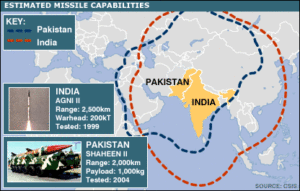
South Asia with two nuclear rivals India and Pakistan is facing some traditional and non-traditional security threats because of perennial security issues.
‘Disparity’ is a more appropriate term when describing the Indo-Pak equation. India sees itself as a rising regional and extra-regional power and considers military power as the main element in the regional power structure. Like any aspiring regional player, India also seeks potential partners such as the United States; and is wary of potential rivals such as China and Pakistan. Pakistan, being in different position, seeks to deter any offense from India. However, India has started adopting an offensive-defensive posture which poses greater challenges to the already fragile regional security.
In numerical terms of population, economics, military manpower and equipment, it is almost meaningless to discuss an India-Pakistan balance. India’s defense partnership with Israel is a critical example of India’s designs to upgrade and modernize its military might.
The Indian security establishment came up with the Cold Star Doctrine to address the future threats from Pakistan with massive conventional force. The ‘Indo-US Strategic Partnership’ is an indication of not only Indian ambitions, but also a sign to follow the aggressive diplomacy in the region.
Indo-US cooperation in high-tech defense equipment has raised concerns in Pakistan that have compelled it to look for advanced weapons technology. Such compulsions may create a path towards destabilization of the strategic balance in the region. India and Israel in future may also work in partnership to induct Dvora-III vessels into the Indian Navy to secure an edge over Pakistan when it comes to contesting claims between the two countries over the Exclusive Economic Zone in the Arabian Sea, specifically in the Sir Creek area.
With the changing strategic dynamics, Pakistan finds itself in an altogether different position. However, Pakistan is well aware of the situation as Ex-Chief of Army Staff General Raheel Sharif mentioned: “Pakistan is capable of dealing with all kinds of internal and external threats, be it conventional or sub-conventional, cold start or hot start. We are ready.”
Be that as it may, with India enlarging its defense production; Pakistan needs to deter any offense not only for the future, but also for its present efforts in the War on Terror. Given India’s massive defense budget and its overall military strength regarding sheer numbers, Pakistan should invest in defense technologies that maximize its capabilities against any enemy, be it external or internal. Pakistan needs to continue the development of tactical nuclear weapons to deter India from launching a limited war. On the diplomatic front, Pakistan should continue to highlight India’s offensive designs in the region as well as internationally. In the changing view of international and regional security dynamics, Pakistan has to maintain a stable posture on Full Spectrum Deterrence (FSD).
Most importantly Pakistan should keep its nuclear doctrine ambiguous. As per Indian security experts’ writing and expressing visible fears, India still does not know at what point Pakistan would cross its nuclear threshold. This feeling of doubt and fear deters India from carrying out any conventional adventure such as surgical strikes inside Pakistan.Pakistan should start focusing on improving its network-centric and electronic warfare capabilities. Pakistan must take every effort to complete the China-Pakistan Economic Corridor (CPEC) since it would create strategic interdependence of China on Pakistan. China, being the strongest player, both economically and militarily, in the region with a permanent seat in the United Nations Security Council (UNSC), would not like any conflict between Pakistan and India and could use its influence internationally, if so needed.
Nevertheless, India’s offensive posture is a harbinger of grave dangers for South Asia, especially for Pakistan. Along with that, Aggressive Indian policies have already provoked an arms race in the region. According to Teresita C. Schaffer, a former U.S. diplomat and a senior analyst with Brookings Institute: “In a nuclear environment, the conventional war concept propagated by India is not logical, it is not possible to quantify the concept of limited war regarding geography, weapons or political objectives in the Indo-Pakistan equation. A limited war from the Indian point of view may not be limited from Pakistani perspective”.
Pakistan desires peace and seeks cordial relations with all its neighbors, especially with India since indulgence in any war may be more costly to the former than the latter. The technological developments in India including Anti-Ballistic Missile (ABM) systems and its defense agreements with other countries especially Israel and the US, is worsening the strategic picture of South Asia. India’s continuing arms build-up not only means more suffering for its poverty-ridden people, but also for the people of Pakistan.
